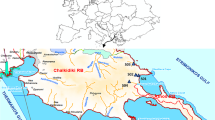Abstract
We present three different approaches to modelling extreme values of daily air pollution data. We fitted a generalized extreme value distribution to the monthly maxima of daily concentration measures. For the exceedances of a high threshold depending on the data, the parameters of the generalized Pareto distribution were estimated. Accounting for autocorrelation, clusters of exceedances were used. To obtain information about the relationship of the exceedance of the air quality standard and possible predictors we applied logistic regression. Results and their interpretation are given for daily average concentrations of ozone and nitrogen dioxide at two monitoring sites within the city of Munich.
Similar content being viewed by others
References
Davison, A.C. and Smith, R.L. (1990) Models for exceedances over high thresholds.Journal of the Royal Statistical Society B52, 393–442.
Fisher, R.A. and Tippett, L.H.C. (1928) Limiting forms of the frequency distributions of the largest or smallest member of a sample.Proceedings of the Cambridge Philosophical Society 24, 180–90.
Gumbel, E.J. (1958)Statistics of Extremes. Columbia University Press, New York.
Hosking, J.R.M. and Wallis, J.R. (1987) Parameter and quantile estimation for the generalized pareto distribution.Technometrics 29, 339–49.
Hosking, J.R.M., Wallis, J.R. and Wood, E.F. (1985) Estimation of the generalized extreme-value distribution by the method of probability-weighted moments.Technometrics 27, 251–61.
Hosmer, D.W. and Lemeshow, S. (1989)Applied Logistic Regression. Wiley, New York.
Küchenhoff, H. and Wolf, R. (1995) Time series analysis of daily air pollution data. Technical Report, University of Munich.
Leadbetter M.R., Lindgren, G. and Rootzén, H. (1983)Extremes and Related Properties of Random Sequences and Processes. Springer-Verlag. New York.
Pickands, J. (1975) Statistical inference using extreme order statistics.Annals of Statistics 3, 119–31.
Rao, S.T., Sistla, G. and Henry, R. (1992) Statistical analysis of trends in urban ozone air quality.Journal of the Air Waste Management Association 42, 1204–11.
Resnick, S.I. (1987)Extreme Values, Regular Variation and Point Process. Springer-Verlag, New York.
Smith, R.L. (1984) Threshold methods for sample extremes. InStatistical Extremes and Applications, J. Tiago de Oliveira (ed.). Reidel, Dordrecht: pp. 621–638.
Smith, R.L. (1989) Extreme value analysis of environmental time series: an application to trend detection in ground-level ozone.Statistical Science 4, 367–393.
Author information
Authors and Affiliations
Rights and permissions
About this article
Cite this article
Kütchenhoff, H., Thamerus, M. Extreme value analysis of Munich air pollution data. Environ Ecol Stat 3, 127–141 (1996). https://doi.org/10.1007/BF02427858
Received:
Revised:
Issue Date:
DOI: https://doi.org/10.1007/BF02427858




